Chapter 14
Managing E-Mail with Outlook
In This Chapter
![]() Configuring e-mail account settings
Configuring e-mail account settings
![]() Creating e-mail
Creating e-mail
![]() Adding file attachments
Adding file attachments
![]() Reading e-mail
Reading e-mail
![]() Deleting e-mail
Deleting e-mail
Microsoft Outlook is the personal organizer portion of Office 2013 for tracking appointments, storing names and addresses of important people, and keeping a list of to-do tasks. However, the most popular uses for Outlook are reading, writing, and organizing your e-mail.
Configuring E-Mail Settings
The first time you run Outlook, you need to configure your e-mail account information. To retrieve e-mail from your account within Outlook, you may need to know the following:
![]() Your name
Your name
![]() The username of your e-mail account, which may be JSmith (for Joe Smith)
The username of your e-mail account, which may be JSmith (for Joe Smith)
![]() Your e-mail address (such as
Your e-mail address (such as [email protected])
![]() Your e-mail account password
Your e-mail account password
![]() Your e-mail account type (such as POP3 or IMAP)
Your e-mail account type (such as POP3 or IMAP)
![]() Your incoming mail server name (such as
Your incoming mail server name (such as pop.microsoft.com)
![]() Your outgoing mail server name (such as
Your outgoing mail server name (such as smtp.microsoft.com)
Before you can use Outlook to manage your e-mail, you must add your e-mail account. The first time you run Outlook, the program will try to set up an e-mail account to use.
If you want to add a new e-mail account later, follow these steps:
1. Load Outlook and click the File tab.
2. Click Info and then click the Add Account button.
An Add Account dialog box appears, as shown in Figure 14-1.
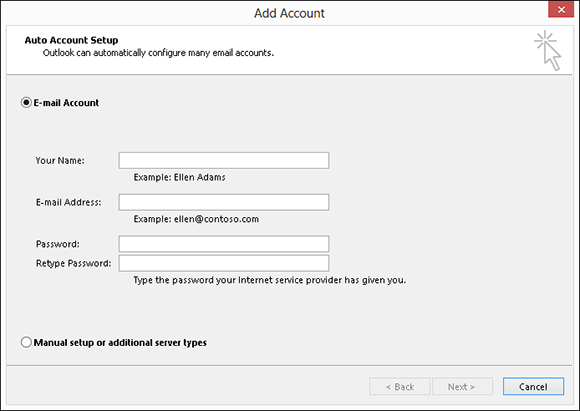
Figure 14-1: The Add Account dialog box lets you create an e-mail account to work with Outlook.
3. Type in the appropriate information and click Next.
You may need to wade through several sets of questions before Outlook can properly configure your e-mail account.
Creating E-Mail
After you set up an e-mail account, you can start sending e-mail. The three ways to create and send e-mail are
![]() Create a message and type the recipient’s e-mail address manually.
Create a message and type the recipient’s e-mail address manually.
![]() Reply to a previously received message. Outlook then adds the recipient’s e-mail address automatically.
Reply to a previously received message. Outlook then adds the recipient’s e-mail address automatically.
![]() Create a message and use a previously stored e-mail address. Outlook adds the e-mail address automatically.
Create a message and use a previously stored e-mail address. Outlook adds the e-mail address automatically.
Creating a new e-mail message
The most straightforward way to send a message is to type the recipient’s e-mail address and then type your message. To create a new e-mail message and type the e-mail address, follow these steps:
1. Click the Mail icon in the bottom-left corner of the Outlook window.
2. Click the Home tab and then click the New Email icon.
Outlook displays a message window, as shown in Figure 14-2. Notice that the message window displays a Ribbon with File, Message, Insert, Options, Format Text, and Review tabs.

Figure 14-2: The message window lets you type and format a message.
3. Click in the To text box and type the e-mail address of the person you want to receive your message.
 Make sure that you type the e-mail address correctly. One incorrect character, and your message won’t go to your intended recipient.
Make sure that you type the e-mail address correctly. One incorrect character, and your message won’t go to your intended recipient.
4. (Optional) Click in the Cc text box and type another e-mail address to send the message to more than one person.
5. Click in the Subject text box and type a brief description of your message.
 Many people use spam filters that examine the Subject line of a message, so it’s a good idea not to type your subject text in ALL CAPITAL LETTERS or use multiple exclamation points!!! Otherwise your recipient’s spam filter may inadvertently flag your message as spam and delete it before anyone can even read it.
Many people use spam filters that examine the Subject line of a message, so it’s a good idea not to type your subject text in ALL CAPITAL LETTERS or use multiple exclamation points!!! Otherwise your recipient’s spam filter may inadvertently flag your message as spam and delete it before anyone can even read it.
6. Click in the message text box and type your message.
 If you click the Save icon on the Quick Access toolbar (or press Ctrl+S), you can store the message in your Drafts folder so you can edit and send it at a later time.
If you click the Save icon on the Quick Access toolbar (or press Ctrl+S), you can store the message in your Drafts folder so you can edit and send it at a later time.
7. Click the Send icon to send your message.
Replying to an e-mail message
Oftentimes, you may receive a message from someone else and want to send a reply to that person. When you send a reply, Outlook automatically copies the original message as part of your e-mail; that way, the recipient can read the original message that you’re responding to.
Even better, when you reply to a message, you won’t have to retype the recipient’s e-mail address and risk misspelling it. To reply to an e-mail message, follow these steps:
1. Click the Mail icon in the bottom-left corner of the Outlook window.
2. Click the Home tab.
Outlook displays the Mail pane.
3. Click a message that you want to reply to.
Outlook displays the contents of that message in a pane on the right side of the Outlook window.
4. Click the Reply icon in the Respond category.
Outlook displays a message window with the recipient’s e-mail address and subject line already typed in, along with a copy of the original message.
 If you click the Forward icon instead of the Reply icon, you can send a message to another person instead of the person who originally sent you the message.
If you click the Forward icon instead of the Reply icon, you can send a message to another person instead of the person who originally sent you the message.
5. Click in the message text box and type your message.
 If you click the Save icon on the Quick Access toolbar in the upper-left corner of the screen, you can store the message in your Drafts folder so you can edit and send it at a later time.
If you click the Save icon on the Quick Access toolbar in the upper-left corner of the screen, you can store the message in your Drafts folder so you can edit and send it at a later time.
6. Click the Send icon.
Using a stored e-mail address to create a new e-mail message
If you send e-mail to certain people regularly, you can type a particular person’s e-mail address once, store it, and then have Outlook type that e-mail address whenever you need it again.
To store an e-mail address, follow these steps:
1. Click the Mail icon in the bottom-left corner of the Outlook window.
2. Click the Home tab and click the Address Book icon in the Find category.
The Address Book: Contacts window appears, as shown in Figure 14-3.
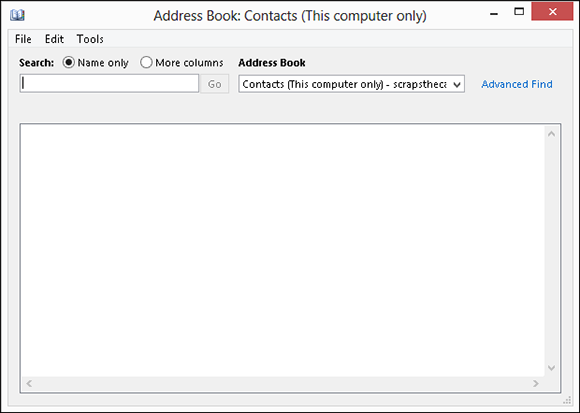
Figure 14-3: The Address Book: Contacts window lets you store e-mail addresses.
3. Choose File⇒New Entry.
A New Entry dialog box appears.
4. Choose New Contact and click OK.
A Contact window appears, as shown in Figure 14-4.
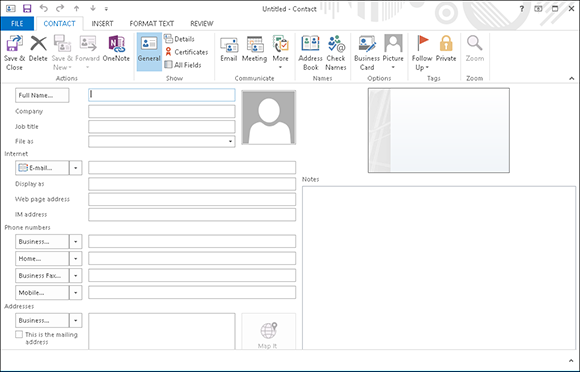
Figure 14-4: The Contact window lets you add a name and e-mail address.
5. Click in the Full Name text box and type a person’s name.
6. Click in the E-mail text box and type a person’s e-mail address.
7. Click the Save & Close icon.
Your newly added name appears in the Address Book: Contacts window.
8. Choose File⇒Close.
After you have stored at least one name and e-mail address, you can retrieve that e-mail address to send a message by following these steps:
1. Click the Mail icon in the bottom-left corner of the Outlook window.
2. Click the Home tab and click the New Email icon in the New category.
The Message window appears.
3. Click the To button.
The Select Names: Contacts dialog box appears, listing all your stored names and e-mail addresses.
4. Click a name to select it.
5. Click the To button at the bottom of the Select Names: Contacts dialog box.
6. Click OK.
Outlook automatically enters your chosen e-mail address in the To text box.
7. Click in the Subject text box and type a brief description of your message.
8. Click in the message text box and type your message.
 If you click the Save icon on the Quick Access toolbar, you can store the message in your Drafts folder so you can edit and send it at a later time.
If you click the Save icon on the Quick Access toolbar, you can store the message in your Drafts folder so you can edit and send it at a later time.
9. Click the Send icon to send your message.
Attaching Files to Messages
Rather than just send plain text, you can also attach a file to your message. This file can be anything from a picture, a song (stored as an audio file), a program, a video file, or even another e-mail message.
If you want to send someone a picture, video, audio file, compressed file, or even an entire program, you need to attach that file to a message by following these steps:
1. Follow the steps in the earlier section, “Creating E-Mail,” to create a new e-mail message, type a subject, and type an e-mail address.
2. Click the Insert tab.
3. Click the Attach File icon in the Include group.
The Insert File dialog box appears.
4. Click the file you want to attach to your message and then click Insert.
Outlook displays an Attached text box in the message window, as shown in Figure 14-5.
 If you hold down the Ctrl or Shift key while clicking a file, you can select multiple files at once.
If you hold down the Ctrl or Shift key while clicking a file, you can select multiple files at once.
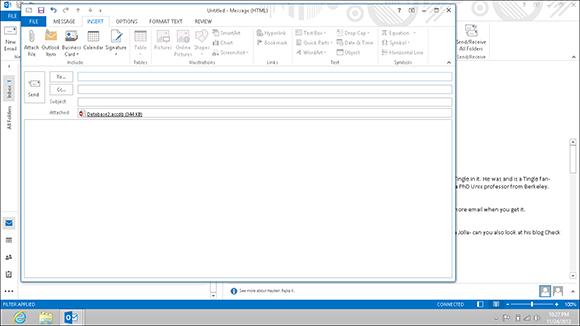
Figure 14-5: Every message with a file attachment displays an Attached text box that displays the filename attached to the message.
5. (Optional) Right-click any file in the Attached text box; when a pop-up menu appears, choose Remove if you change your mind about attaching a file to a message.
6. Click the Send icon.
Reading and Organizing E-Mail
One of the biggest problems with receiving e-mail is trying to sort through all the important messages. To help you organize your e-mail, Outlook offers several ways to group related messages together and search for specific text in messages so you can find exactly what you need.
Grouping messages into categories
Outlook can display messages with the newest message on top and the oldest message at the bottom (or vice versa). In addition, Outlook can also group messages according to Date, Subject, Size, or even by e-mail accounts.
To view and sort your e-mail messages, follow these steps:
1. Click the Mail icon in the bottom-left corner of the Outlook window.
2. Click the View tab.
The different ways to arrange e-mail messages appears in the Arrangement category, as shown in Figure 14-6.
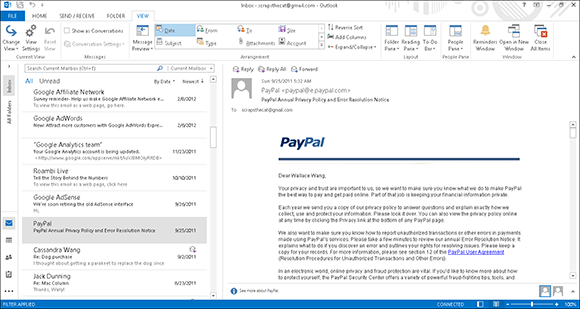
Figure 14-6: The Arrange-ment category lets you choose how to organize your e-mail messages.
3. Click a category such as Date, Size, From, or Account.
Outlook sorts your messages.
4. (Optional) Click Reverse Sort.
Outlook sorts your messages in reverse order, such as oldest to newest or newest to oldest.
Changing the appearance of the Reading Pane
To make reading e-mail messages easier, Outlook can display your messages in three different ways:
![]() Right: Lists of messages appear in the left side of the Outlook window and the currently selected message appears in the right side of the Outlook window.
Right: Lists of messages appear in the left side of the Outlook window and the currently selected message appears in the right side of the Outlook window.
![]() Bottom: Lists of messages appear in the top of the Outlook window and the currently selected message appears in the bottom of the Outlook window.
Bottom: Lists of messages appear in the top of the Outlook window and the currently selected message appears in the bottom of the Outlook window.
![]() Off: Only lists of messages appear in the Outlook window. To see the contents of a single message, you have to double-click that message.
Off: Only lists of messages appear in the Outlook window. To see the contents of a single message, you have to double-click that message.
To change the way Outlook displays your e-mail messages, follow these steps:
1. Click the Mail icon in the bottom-left corner of the Outlook window.
2. Click the View tab.
3. Click the Reading Pane icon in the Layout category.
A menu appears, as shown in Figure 14-7.

Figure 14-7: The Reading Pane menu.
4. Choose an option such as Right, Bottom, or Off.
Outlook displays your messages in your chosen configuration, as shown in Figure 14-8.

Figure 14-8: Displaying messages in the Bottom Reading Pane view.
Retrieving a file attachment from a message
Rather than just send text, people may send you pictures, word-processor documents, or databases as file attachments. When you receive a message with a file attachment, Outlook displays a paper clip icon next to the message.
To open a file attachment, follow these steps:
1. Click a message that displays a paper-clip icon.
Outlook displays the message’s contents with the file attachments listed, as shown in Figure 14-9.
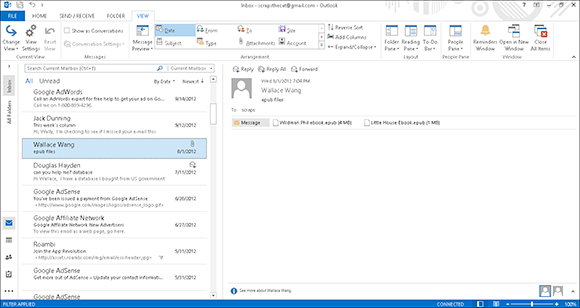
Figure 14-9: Each file attachment appears as a tiny icon.
2. Double-click the file (paper clip) icon displayed in the message.
An Opening Mail Attachment dialog box appears, giving you the option to open the file directly or save it as shown in Figure 14-10. Unless you trust the file contents, it’s usually best to save the file in a directory and scan it with your antivirus program.

Figure 14-10: The Opening Mail Attachment dialog box lets you choose to open or save a file attachment.
Deleting E-Mail Messages
To keep your Inbox folder from getting too cluttered, you can always delete messages that you’re sure you’ll never need to read again. To delete a message, follow these steps:
1. Click the Mail icon in the bottom-left corner of the Outlook window.
2. Click the Home tab.
3. Click the message you want to delete.
4. Press Delete or click the Delete icon in the Delete group.
If you accidentally delete the wrong e-mail message, you can undelete it by pressing Ctrl+Z or clicking the Undo icon in the Quick Access toolbar.
